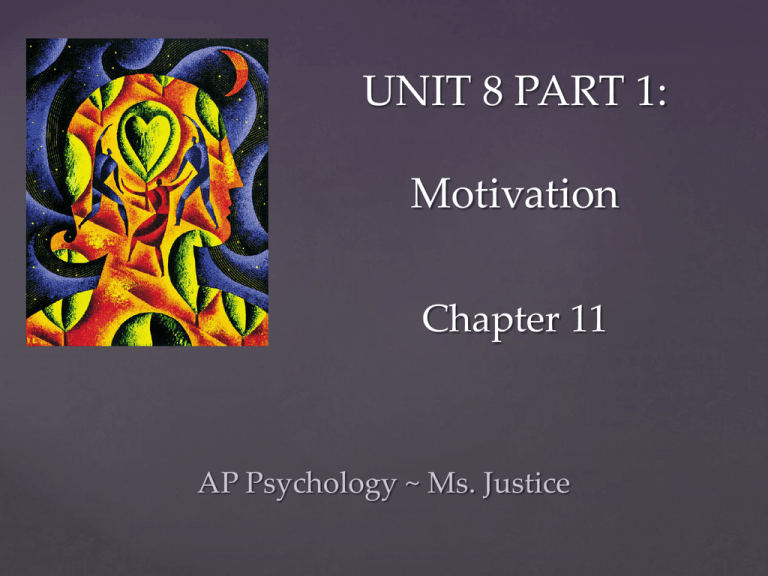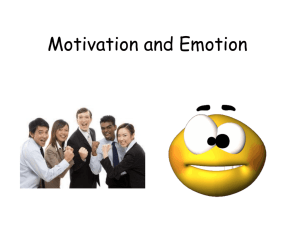
UNIT 8 PART 1:
Motivation
{
Chapter 11
AP Psychology ~ Ms. Justice
BIG IDEAS
Motivational Concepts
Hunger
Sexual Motivation
The Need to Belong
Best Motivation Video Ever?
Motivation
Motivation is a need or
desire that energizes
behavior and directs it
towards a goal.
Would you ever be
motivated to cut off your
own arm?
Aron Ralston was
motivated to do so in order
to free himself from a rock
that pinned him down.
1: From what
perspectives do
psychologists view
motivated behavior?
Perspectives on Motivation
Four perspectives used to explain motivation include
the following:
1. Instinct Theory (replaced by the
evolutionary perspective)
2. Drive-Reduction Theory
3. Arousal Theory
4. Hierarchy of Motives
Instincts & Evolutionary Psychology
Instincts are complex behaviors that have
fixed patterns throughout different species
and are not learned.
© Ariel Skelley/ Masterfile
Where the woman builds different kinds of houses,
the bird builds only one kind of nest.
Drives and Incentives
When the instinct theory of motivation failed, it
was replaced by the drive-reduction theory the idea that a physiological need creates an
aroused tension state (a drive) that motivates an
organism to satisfy the need.
Incentive
Where there is both a need and an incentive
(positive or negative stimuli that motivates
behavior), we feel strongly driven.
A food-deprived person (need)
who smells baking bread (incentive)
feels a strong hunger drive.
Optimum Arousal
Human motivation aims to seek optimum levels
of arousal, not to eliminate it.
When other needs are met, young monkeys and
children are known to explore the environment
in the absence of a need-based drive.
Randy Faris/ Corbis
Harlow Primate Laboratory, University of Wisconsin
A Hierarchy of Motives
Abraham Maslow (1970)
suggested that certain
needs have priority over
others:
Physiological needs like
breathing, thirst, and
hunger come before
psychological needs such
as achievement, selfesteem, and the need for
recognition.
(1908-1970)
Hierarchy of Needs
Fig. 11.2,
p. 447
2: What physiological
factors produce hunger?
The Physiology of Hunger
Stomach contractions (pangs) send
signals to the brain making us
aware of our hunger.
But, research has shown that hunger persists
without stomach pangs: Tsang (1938) removed rat
stomachs, connected the esophagus to the small
intestines, and the rats still felt hungry (and ate
food).
Body Chemistry & the Brain
Levels of glucose in the
blood are monitored by
receptors (neurons) in the
stomach, liver, and
intestines.
They send signals to the
hypothalamus in the brain.
Hypothalamic Centers
The lateral hypothalamus (LH) brings on hunger.
Destroy the LH, and the animal has no interest
in eating.
The ventromedial
hypothalamus (VMH)
depresses hunger (makes you
feel full).
Destroy the VMH, and the
animal eats excessively.
3: What psychological
and cultural factors
influence hunger?
The Psychology of Hunger
Memory plays an important role in hunger.
Due to difficulties with retention, amnesia
patients eat frequently if given food
(Rozin et al., 1998).
This suggests that part of knowing
when to eat is our memory of our last meal.
Taste Preference: Biology or Culture?
Body chemistry and environmental factors
influence not only when we feel hunger but what
we feel hungry for!
Whale blubber!
Roasted ants!
The Ecology of Eating
When given a
large serving
utensils or a
large
bowl/plate,
we take more
food.
We eat more when
eating with others.
When offered a
supersized portion,
we put away more
calories.
4: How do anorexia nervosa, bulimia
nervosa, and binge-eating disorder
demonstrate the influence of
psychological forces on
physiologically motivated behaviors?
Eating Disorders
Anorexia Nervosa:
A condition in which a normalweight person (usually an
adolescent woman)
continuously loses weight but
still feels overweight.
1930s
2010
Eating Disorders
Bulimia Nervosa: A disorder
characterized by episodes of
overeating, usually highcalorie foods, followed by
vomiting, using laxatives,
fasting, or excessive exercise.
Changes in body size
throughout history…
Venus of Willendorf: c. 22,000-21,000 BCE
The Arrival of Marie de' Medici at Marseilles,
by Peter Paul Rubens 1622-26
The Bathers, by Pierre Auguste Renoir 1887
1950s sex symbol Marilyn Monroe was a size 10
Modern-day fashion model vs. Holocaust victim
The Media & Body Image:
Killing Us Softly: Advertising’s Image of Women
The Media & Body Image:
Dove’s The Evolution of Beauty
Dove’s Campaign for Real Beauty
The goal of the
Operation Beautiful website
is to end negative self-talk
or “Fat Talk.”
5: What factors predispose some
people to become and remain
obese?
Obesity
Obesity is a disorder characterized by being
excessively overweight.
Obesity increases the risk for health issues like
cardiovascular diseases, diabetes, hypertension,
arthritis, and back problems.
http://www.cyberdiet.com
Body Mass Index (BMI)
A BMI of 30 or more = obese.
Obesity in children increases their risk of diabetes, high blood
pressure, heart disease, gallstones, arthritis, and certain types
of cancer, thus shortening their life-expectancy.
2007
Obesity Rates Around the World, 2010
Social Effects of Obesity
When female job
applicants were made to
look overweight, subjects
were less willing to hire
them.
Physiology of Obesity
Fat Cells: There are 30-40 billion fat cells in the body.
These cells can increase in size (2-3 times their
normal size) and number (75 billion) in an obese
individual (Sjöstrum, 1980).
The Genetic Factor
Studies reveal that body weight has a genetic basis:
• Identical twins have closely similar weights, even
when reared apart.
• Given an obese parent, boys are 3x more likely,
and girls 6x more likely to be obese than those
with normal-weight parents.
• Adoptive siblings’ body weights are uncorrelated;
people’s weights resemble those of their biological
parents and siblings.
Activity
Lack of exercise is a major contributor to obesity.
Just watching TV for two hours resulted in a 23%
increase of weight when other factors were
controlled (Hu & others, 2003).
Food Consumption
Over the past 40 years, average weight gain has
increased. Health professionals are pleading with
US citizens to limit their food intake.
6: What stages mark the human
sexual response cycle?
Sexual Motivation
Sexual motivation is
nature’s clever way of
making people procreate,
enabling our species to
survive.
The Physiology of Sex
Masters and Johnson (1966) describe the human sexual
response cycle as consisting of four phases:
Phase
Physiological Response
Excitement
Genitals become engorged with blood. Vagina
expands secretes lubricant. Penis enlarges.
Plateau
Excitement peaks such as breathing, pulse and blood
pressure.
Orgasm
Contractions all over the body. Increase in breathing,
pulse & blood pressure. Sexual release.
Resolution
Engorged genital release blood. Male goes through
refractory phase. Women resolve slower.
Pages 465-466
Sexual Problems
Men generally suffer from two kinds of sexual
problems: premature ejaculation and erectile disorder.
Women may suffer from orgasmic disorders.
These problems are not due to
personality disorders and can be
treated through behavior therapy
and drugs such as Viagra.
7: Do hormones influence human
sexual motivation?
Hormones and Sexual Behavior
Sex hormones effect the development of sexual
characteristics and (especially in animals)
activate sexual behavior.
Testosterone
Male
Female
Testes
(Small amounts of estrogen)
Ovaries
Estrogen
Adrenals
(Small amounts of
testosterone)
Facts About Estrogen & Testosterone
Women become sexually receptive when
estrogen levels peak during ovulation.
Women are more likely to have sex when
close to ovulation (increased testosterone).
Testosterone levels remain relatively constant
in males, so it is difficult to manipulate and
activate sexual behavior.
Men show increased testosterone levels when
socializing with women.
8: How do internal and external
stimuli influence sexual
motivation?
The Psychology of Sex
Hunger responds to a need. If we do not eat, we die.
In that sense, sex is not a need because if we do not
have sex, we do not die.
Figure 11.14, p. 468
External Stimuli
It is common knowledge that men become sexually
aroused when browsing through erotic material.
Adverse effects of sexually explicit material:
People may begin to devalue their own partners
and relationships
Satisfaction with a sexual partner can decrease
Can lead to acceptance of the false idea that
women enjoy rape, and can increase violence
against women
Imagined Stimuli
Sotographs/The Gamma-Liaison Network/ Getty Images
Is the brain our most significant sex organ?
Our imagination in our brain can influence
sexual arousal and desire.
People with spinal cord injuries and no genital
sensation can still feel sexual desire.
9: What factors influence teen
pregnancy and risk of sexually
transmitted infections?
Adolescent Sexuality
When individuals reach adolescence, their
sexual behavior develops. However, there are
cultural differences.
Sexual promiscuity in
modern Western culture is
much greater than in Arab
countries and other Asian
countries.
Reasons for Lack of
Contraception Use Among Teens
1.
2.
3.
4.
5.
Ignorance: Surveys indicate that teens often do not have
the right ideas about birth control methods.
Guilt Related to Sexual Activity: Guilt reduces sexual
activity, but it also reduces the use of contraceptives.
Minimal Communication: Many teenagers feel
uncomfortable discussing contraceptives.
Alcohol Use: Those who use alcohol prior to sex are less
likely to use contraceptives.
Mass Media: The media’s portrayal of unsafe extramarital
sex decreases the use of contraceptives.
Sexually Transmitted Infections
Many sex ed. programs in the U.S. place a greater
emphasis on abstinence to reduce STIs.
Factors that reduce sexual activity in teens:
1.
2.
3.
4.
High Intelligence: Teens with higher intelligence
are likely to delay sex.
Religiosity: Religious teens and adults often reserve
sex for a marital commitment.
Father Presence: A father’s absence from home can
contribute to higher teen sexual activity.
Learning Programs: Teens who volunteer and tutor
in programs dedicated to reducing teen pregnancy
are less likely to engage in unsafe sex.
10: What has research taught us
about sexual orientation?
Sexual Orientation
Sexual orientation refers to a person’s preference
for emotional and sexual relationships with
individuals of the same sex, the other sex, and/or
either sex.
Homosexual
Heterosexual
Bisexual
Origins of Sexual Orientation
Homosexuality is more likely based on
biological factors like differing brain centers,
genetics, and prenatal hormone exposure rather
than environmental factors.
Cynthia Johnson/ Time magazine
Homosexual parents
Animal Homosexuality
David Hecker/ AFP/ Getty Images
A number of animal
species are devoted to
same-sex partners,
suggesting that
homosexuality exists
in the animal world.
Wendell and Cass
Genes & Sexual Orientation
A number of reasons suggest that
homosexuality may be due to genetic factors.
1.
2.
3.
Family: Homosexuality seems to run in families.
Twin studies: Homosexuality is more common in
identical twins than fraternal twins. However, there
are mixed results.
Fruit flies: Genetic engineers can genetically
manipulate females to act like males during
courtship and males to act like females.
Table 11.1, p. 476
11: Is scientific research on sexual
motivation value free?
Sex and Human Values
Most researchers strive to keep their own values out
of the discussion of sexual behavior.
Andreanna Seymore/ Getty Images
12: What evidence points to our
human need to belong?
The Need to Belong
“[Man] is a social animal,” (Aristotle).
Separation from others increases our need to belong.
20th Century Fox/ Dreamworks/ The Kobal Collection
“Cast Away,” Tom Hanks, suffers
from social starvation.
Belongingness
1.
2.
3.
4.
Wanting to Belong: The need to belong colors our
thinking and emotions.
Social Acceptance: A sense of belonging with others
increases our self-esteem. Social segregation decreases it.
Maintaining Relationships: We resist breaking social
bonds, even bad ones.
Ostracism: Social exclusion leads to demoralization,
depression, and at times
nasty behavior.









